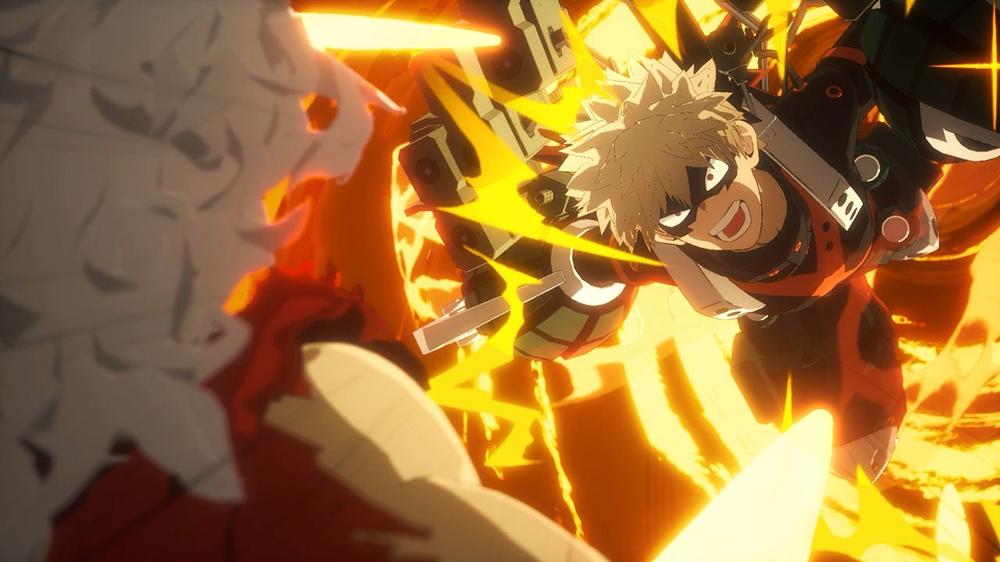One of the lost arts in the fighting game genre is a good, meaty single-player mode that’s there in addition to your standard arcade runthrough or story mode. And no, Street Fighter 6’s “We have Yakuza at home” World Tour doesn’t count. Think Soul Calibur’s excellent Weapon Master or Guilty Gear’s absolutely bonkers M.O.M. The art isn’t gone – Tekken 8’s awesome Arcade Quest is right there – but it’s on life support. I got the chance to sit down with My Hero Academia: All’s Justice at Tokyo Game Show, and what I played of its Team-Up Missions just might be the shot in the arm fighting games need – at least when it comes to single-player modes.
VR but Not VR
What makes All Justice’s spin on this unique is that the whole thing is an original story developed in conjunction with the creators of the manga and the anime. The other interesting thing here is that it all takes place inside a virtual reality program. But All's Justice isn’t just doing its best Metal Gear Solid 2 impression, and this isn’t just a string of fights. You’ll be exploring the virtual world of All’s Justice, too. In fact, I found running around, doing side quests, and just enjoying The Vibe to be as compelling as My Hero Academia’s brawls. But I’m getting ahead of myself. Let’s load up my VR tour from the start.
My journey began with Izuku “Deku” Midoriya and Toshinori “All Might” Yagi exploring the VR world of the Team-Up Missions when they get a call from Mei Hatsume, who needs your help to fix a Nomu whose programming has gone haywire. Sounds like a job for a superhero, so off I go. After a quick battle against the Nomu that serves as a very basic tutorial, the rest of Class 1-A shows up to back Deku up. From there, I was cut loose for a couple more missions and allowed to explore the world.
The coolest thing about All’s Justice is that you’re not just running from one map marker to the another looking for The Next Thing. In fact, Deku and I quickly got sidetracked. We were supposed to be training with All Might when Ochaco “Uravity” Uraraka called and asked for my help, so I whipped my way over to her. See, you can use each hero’s Quirks (If you’re unfamiliar with My Hero Academia, a Quirk is a person’s superpower) to navigate the world. That means that when you’re Deku, you’re swinging around like some kind of Legally Distinct Spider-Man. When I arrived, I found that Uraraka was helping a little girl look for her lost cat. All right, My Hero Academia. I’m immediately charmed. We saw the cat up on the roof; the only problem was getting there. While Deku’s Definitely Not Web-Slinging is great for getting around, it’s not really ideal for leaping a tall building in a single bound and rescuing a lost kitty.
Good thing we’re playing Team-Up Missions, huh? A quick switch to Uravity and one use of anti-gravity powers later, and I was up, up, and away and soon reuniting a very happy little girl with her adorable cat. Producer Aoba Miyazaki told me that this stuff was key to nailing the feeling of My Hero Academia. Battles are important, yeah, but the series is also about high school students learning to be heroes, and that means being in that world and interacting with those people was just as important.
Friendly Neighborhood Superteam
Cat saved, it was time to train with All Might. We were essentially playing Hide and Seek: we’d complete tasks assigned by Pro Heroes and get the clues we needed to find All Might. Turn us loose on the world, All Justice’s. We’re ready. And if the whole saving the cat thing wasn’t a clue, not everything’s going to be a fight.
Don’t get me wrong: All Justice’s is still an arena fighter, and if you’ve played one, you know what to expect. You’ve got your basic combos, unblockable attacks, special moves that vary between characters, a super-powered mode known as Rising, and your Plus Ultra ultimate attacks. You can also tag in your partners mid-combo when you absolutely, positively have to rearrange someone’s face. It’s great fun, even if you’re just scraping by while Endeavor is pummelling you and you’re trying to remember the controls. I was yelling “It’s fine!” a lot during the fights when it was most assuredly not fine, but I clutched them out.
But there was other stuff, too. One time, I had to race to the top of a building before time ran out, but Ochaco couldn’t just float up to it. We had to find buildings we could use as stepping stones to get us where we needed to be. And everyone has their own different traversal options. Froppy can climb up buildings because she’s essentially a frog. Bakugo can use his explosions to boost himself to higher places. Koda can speak to animals, and that can help you out, too. I didn’t get to see that one in action, but I bet it’s great for finding cats.
There are also lots of side missions, both with other heroes and regular citizens. At one point, I was walking down an alley when a random villain pulled up, looking to throw down. Let me tell you, that dude came to the wrong neighborhood. I sent him flying through like an entire rack full of bikes, which became kind of a running theme. Deku and his friends are heroes, but if you own a bicycle, these dudes are a menace. Well, at least when I’m piloting him.
Superhero Around Town
There are also buildings to heal up your team between battles, but Miyazaki told me that there are also challenge gyms if you’re looking for something tougher. In addition, the map for the main story and the Team-Up Missions are connected, so you can transfer from one mode to the other by just running around. She also told me that completing the Team-Up Missions unlocks two other modes: Archives mode and Hero Diaries. You can play out iconic fights from the series in the former, and the latter lets you see what the Class 1-A crew is up to outside of the anime, just like the Team-Up Missions. What I played of the Team-Up Missions was already charming, but it’s great that there’s more to unlock if you complete them all.
We did eventually track down All Might, and then we had to fight him. You can have up to three characters on your team at any one time, but for this battle, I just had Deku and Uravity. Against All Might, the Big Bad Booty Daddy of My Hero Academia himself. Things started… badly. I almost got happy birthday’d when I made a bad tag and All Might caught both Ochaco and Izuku at the same time, draining about two-thirds of my health with a single combo. I popped Rising mode immediately to try to stay alive, and whittled him down until, at low health, I landed the perfect hit, turned that into a tag combo, and ended with a Plus Ultra that finished All Might off on the very last hit. It was a blast, and a great way to end my time with All’s Justice.
I left My Hero Academia: All’s Justice impressed with the fisticuffs, but also its dedication to building a world where you’re actively being a hero, not just punching something. Like fighting games themselves, being a superhero isn’t just about fights; the stuff between brawls matters, too. My Hero Academia’s cast isn’t just a bunch of Quirked-up pugilists; they’re learning how to be heroes, and that means helping people. Sometimes, saving the cat is the most heroic thing you can do.

 Zelensky warns of 'critical' situation at Zaporizhzhia nuclear plant after weeklong outage
Zelensky warns of 'critical' situation at Zaporizhzhia nuclear plant after weeklong outage